定年退職を前にして思うこと
昨日の2016年3月31日は,私にとっては,記念すべき日になるはずであった。というのも,明治学院大学の定年は,68歳であり,実は,昨日,私は定年退職して,この大学を去るはずだったからである。
ところが,2015年に法科大学院を廃止する代わりに,「法と経営学研究科」を設立して,私が,初代の委員長となったため,その完成年度まで,定年が延長されることになり,私は,もう1年間この大学にとどまることになった。
「法と経営学」とは,経営学と法学の学問分野に生起する諸問題について,経営学と法学の二つの観点から解決する方法を探究することを通じて,究極的には,両者を発展的に融合することをめざす学問である([加賀山・法と経営学序説(2013)1頁])。
それをもう少し具体的にイメージすると以下のような図となる。すなわち,「法と経営学」とは,具体的には,(1)組織自身,(2)金融市場,(3) 労働市場,(4)原材料市場,(5)製品市場,(6)政府関係という六つの学問分野に,法学の学問分野,すなわち,(1)会社法,(2)金融法,(3)労 働法,(4)契約法・知財法,(5)不法行為法・経済法,(6)行政法・税法をマッピングし,あらゆる組織に生起する問題を,法学と経営学の二つの観点か ら解決する方法を探究することを通じて,究極的には,法と経営学を発展的に融合することをめざす学問であるということができる。
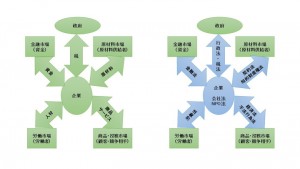 |
| 経営学の学問分野 |
マッピングする法学の学問分野 |
もっとも,経営学,法学は,社会の要請に応じてダイナミックに変化する学問分野であるため,上記の図は,現時点での概念を表象するものに過ぎない([斎藤・法と経営学の視点(2014)287頁])。
2015年,明治学院大学大学院にわが国ではじめての「法と経営学」研究科が設立された。この研究科では,その主要科目であるビジネス総論では,法 学の教員と経営学の教員の二人の教員がひとつの教室に入り,経済小説や実際に生じた経営問題,判例を題材について,法学と経営学の二つの視点から問題解決 の方法を提示し,大学院生との間で議論を重ね,大学院生がグループ討論を通じて結論を導くという方法を取り入れている。
そこで,来年の2017年3月31日が,私の明治学院大学法学部教授としての人生に終止符を打ち,両親が待ち望んでいる大分県の実家に帰り,新たな人生を歩むことになった。
定年退職すると,元気がなくなるという話をよく聞くが,私の場合は,幸いにも,実家が農地なので,そこで晴耕雨読の生活を送るとともに,「日本民法典研究支援センター」というインターネットの組織を立ち上げたので,そこでの質疑応答を通じて,法教育の発展に残りの人生を楽しく送りたいと考えている。
明治学院大学での研究・教育活動を振り返る
明治学院大学での11年間を振り返ると,2005年に法科大学院の設立要員として法科大学院の教授に赴任してから9年間は,法科大学院の教授として法曹教育の改革に取り組むとともに,法学研究科の大学院改革に取り組んだ。
2012年5月6日の法科大学院の教授会で法科大学院の募集停止が決定されると,直ちに,5月14日に,経済学部の有志とともに,法科大学院に代わる研究科,後にその名を「法と経営学研究科」とする修士課程の研究科を創設する計画に取り掛かった。この計画は,明治学院大学の大学院改革の一環として位置づけられ,2013年2月22日に学長の諮問に答える答申「新大学院構想について」として公表され,2014年2月19日の連合教授会で承認された。文部省の設置審の審議も乗り越え,2014年10月29日に,「法と経営学研究科」は,わが国で最初の「法学」と「経営学」の双方の視点から問題解決を行うことを目的とする修士課程の大学院として設立が認可された。
大学教授として業績を伸ばすために必要な情報の「引出し」
大学を退職するに当たって,通常は,最終講義を行う。その際には,嫌でも自分の業績を振り返ることになる。
業績が少ないと,自分は大学でなにをしてきたのかと,憂鬱になるに違いない。そうならないうちに,定年退職の最終講義に何を述べるかを早くから考えておくのがよい。
その際には,大学教授は何をすべきかについて,よく考えるのがよい。職業としての研究者を目指す人も,すでに,大学教授になっている人も,自らの評価を厳しく行うためには,杉原厚吉『大学教授という仕事』水曜社(2010)をよく読み,大学教授は,その普遍的な責務として,以下の項目を実践すべきであるというのが私の考え方である。
この本で書かれている大学教授の仕事のうち,大切なものをピックアップすると,以下の3つになる。
- コンスタントに独創的な論文を作成すること,
- 独立した研究能力を有する課程博士(ドクター)を輩出すること,
- 研究を遂行するための外部資金を調達すること
最終講義では,すべての教授が,以上の評価基準に従って,教授としての「自己評価」をすべきであるとすれば,大学教員は,就職したときから,自分の最終講義をするための準備をすればよいことになる。
目標実現するために有用なのが引き出しである。上の三つの項目について,引き出しを作って,日々,業績を蓄積し,いつでも,それを引き出せるようにしておくと,目標を実現するのに役立つ。
物理的引出しからアウトラインプロセッサへ
物理的な引出しは,書類等を入れてしまうと,インデックス以外は見えなくなってしまう。すっきりと整理されてよいのだが,中が見えないために,情報が整理されないままに,埋もれてしまう危険性があり,そうなると,情報の蓄積も進まない。
そこで便利になるのが,アウトラインプロセッサである。この中に情報を入れておくと,見出しだけにすることも,中身を見ることも自由自在となる。
たとえば,私は,民法の体系化の作業をこのアウトラインプロセッサ(OlivieneEditor)を使って行っているが,必要な箇所だけを見ることができ,しかも,どこからでも事由に作業をすることができるので,非常に便利である。
たとえば,民法の全体像を見るときには,見出しのレベルを1,すなわち,編だけを見ることができる。
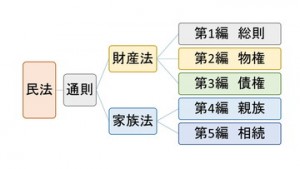
第1篇のうち,章だけをみたければ,章までに限定してみることができる。
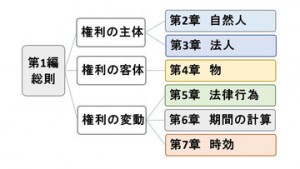
さらに,条文のレベル,たとえば,1条だけを見たければ,そこに限定してみることができる。
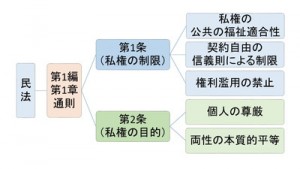
たとえば,私の利用しているアウトラインプロセッサは,ディレクトリ単位で管理しているので,MS-DOSのコマンドプロンプトで構造を見ることもできる。現在の状況は以下の通りである。
Structure of Civil Code of Japan
├─1 Property law
│ ├─Part1 General provisions
│ │ ├─Chapter1 General principles
│ │ │ ├─Section1 Private and public interests
│ │ │ ├─Section2 Standard of act
│ │ │ │ ├─ Art. 1 al. 2 Principle of good faith
│ │ │ │ └─ Art. 1 al. 3 Prohibition of abuse of rights
│ │ │ └─Section3 Aim and Interpretation of civil law
│ │ │ └─Art. 2 Dignity and equality
│ │ ├─Chapter2-3 Person
│ │ │ ├─Chapter2 Natural person
│ │ │ │ ├─Secction1 Capacity to hold rights
│ │ │ │ ├─Section2 Capacity to legal act
│ │ │ │ │ ├─1. Majorities
│ │ │ │ │ ├─2. Minors
│ │ │ │ │ ├─3. Guardianship
│ │ │ │ │ ├─4. Guaratorship
│ │ │ │ │ ├─5. Assistance
│ │ │ │ │ └─6. Right of counterparty
│ │ │ │ ├─Section3 Domicile
│ │ │ │ ├─Section4-1 Management of absentee property
│ │ │ │ ├─Section4-2 Adjudication of disappearance
│ │ │ │ └─Section5 Presumption of simultaneous death
│ │ │ └─Chapter3 Juridical person
│ │ │ └─1. Establishment of juridical person
│ │ ├─Chapter4 Object of right
│ │ │ └─Classification
│ │ │ ├─1. Tangible or Intangible
│ │ │ │ └─Art. 85 Tangible
│ │ │ └─2. Principal or Appurtenance
│ │ │ └─Art. 88 Fruits
│ │ ├─Chapter5 Legal acts
│ │ │ ├─Section1 General provisions of legal acts
│ │ │ ├─Section2 Manifestation of intention
│ │ │ ├─Section3 Agency
│ │ │ │ ├─1. Condition of agency
│ │ │ │ ├─2. Sub-agency
│ │ │ │ ├─3. Conflict of agency
│ │ │ │ ├─4. Apparent agency
│ │ │ │ └─5. Unauthorized agency
│ │ │ ├─Section4 Void or Invalidity of legal acts
│ │ │ │ ├─1. Void
│ │ │ │ └─2. Invalidity
│ │ │ └─Section5 Conditions and Time limit
│ │ │ ├─Conditions
│ │ │ └─Time limit
│ │ ├─Chapter6 Calculation of period
│ │ └─Chapter7 Prescription
│ │ ├─Section1 General provisions
│ │ │ ├─1. Effect and waiver
│ │ │ ├─2. Interruption
│ │ │ └─3. Suspension
│ │ ├─Section2. Acquisitive prescription
│ │ └─Section3. Extinctive prescription
│ │ ├─1. Long term
│ │ └─2. Short term
│ ├─Part2 Real property law
│ │ ├─Chapter1 General provisions of real property
│ │ ├─Chapter2 Possessory rights
│ │ │ ├─Section1 Acquisition of possessory rights
│ │ │ ├─Section2 Effect of possessory rights
│ │ │ │ └─3. Possessory actions
│ │ │ ├─Section3 Extinction of possessory rights
│ │ │ └─Section4 Quasi-possession
│ │ ├─Chapter3 Ownership
│ │ │ ├─Section1 Extent of ownership
│ │ │ │ ├─Subsection1 Content and scope of ownership
│ │ │ │ └─Subsection2 Neighboring relationships
│ │ │ │ ├─1. Use of Land
│ │ │ │ ├─2. Water streams
│ │ │ │ ├─3. Boundary
│ │ │ │ └─4. Structure on land
│ │ │ ├─Section2 Acquisition of ownership
│ │ │ │ ├─1. Possession, finding and discovery
│ │ │ │ └─2. Accession, mixture and processing
│ │ │ └─Section3 Co-ownership
│ │ │ ├─1. Management of co-ownership
│ │ │ ├─2. Partition of co-owned thing
│ │ │ ├─3. Rights of common with nature of co-ownership
│ │ │ └─4. Quasi co-ownership
│ │ ├─Chapter3-2 Rights of usufructuary
│ │ │ ├─Chapter4 Superficies
│ │ │ ├─Chapter5 Emphyteusis
│ │ │ │ ├─1. Acquisition of Emphyteusis
│ │ │ │ └─2. Extinction of emphyteusis
│ │ │ └─Chapter6 Servitudes
│ │ │ ├─1. Acquisition of servitudes
│ │ │ ├─2. Extinction of servitudes
│ │ │ └─3. Common with the nature of servitudes
│ │ └─Chapter3-3. Real security
│ │ ├─Chapter07 Right of retention
│ │ │ ├─1. Acquisition of right of retention
│ │ │ ├─2. Effect of right of retention
│ │ │ └─3. Extinction of right of retention
│ │ ├─Chapter08 Statutory liens
│ │ │ ├─Section1 General provisions
│ │ │ ├─Section2 Kinds of statutory liens
│ │ │ ├─Section3 Order of priority of statutory liens
│ │ │ └─Section4 Effect of statutory liens
│ │ ├─Chapter09 Pledges
│ │ │ ├─Section1 General provisions
│ │ │ ├─Section2 Pledges of movables
│ │ │ ├─Section3 Pledges of immovable properties
│ │ │ └─Section4 Pledges of rights
│ │ └─Chapter10 Mortgages
│ │ ├─Section1 General provisions
│ │ ├─Section2 Effect of mortgages
│ │ │ ├─3. Disposition of mortgages
│ │ │ ├─6. Statutory superficies
│ │ │ └─7. Joint mortgages
│ │ ├─Section3 Extinction of mortgages
│ │ └─Section4 Revolving mortgages
│ │ └─4. Joint revolving mortgages
│ └─Part3 Obligation law
│ ├─Chapter1 General provisions of obligation
│ │ ├─Section1 Object of obligation
│ │ │ ├─1. Obligation to deliver things
│ │ │ ├─2. Monetary obligation
│ │ │ └─3. Alternative obligation
│ │ ├─Section2 Effect of obligation
│ │ │ ├─1. Internal effect
│ │ │ └─2. External effect
│ │ ├─Section3 Obligation of multiple parties
│ │ ├─Section4 Assignment of obligation
│ │ └─Section5 Extinction of obligation
│ │ ├─Novation
│ │ └─Payment (Performance)
│ ├─Chapter2 Contract
│ │ ├─General provisions
│ │ │ └─General provisions
│ │ │ └─Effect of contracts
│ │ └─Types of contracts
│ │ ├─Deposits
│ │ ├─Lease
│ │ └─Sale
│ ├─Chapter3 Management of business
│ │ ├─1. Ordinary Management of business
│ │ │ ├─Condition of management
│ │ │ └─Effect of management
│ │ └─2. Urgent Management
│ ├─Chapter4 Unjust enrichment
│ │ ├─General unjust enrichment
│ │ └─Special unjust enrichment
│ └─Chapter5 Tort
│ ├─General torts
│ │ ├─1.General torts by single tortfeasor
│ │ ├─2.General torts by several tortfeasors
│ │ └─3.Exemptions for tortfeasors
│ │ └─1.Incapacity for liability
│ └─Special torts
│ └─Liability of traffic accident
│ └─2. Causation
└─2 Family law
├─Part4 Relatives
│ ├─ Chapter2 Marriage
│ │ ├─ Section3 Marital Property
│ │ ├─ Section4 Divorce
│ │ └─Section1 Formation of Marriage
│ ├─Chapter3 Parent and Child
│ │ └─ Section2 Adoption
│ ├─Chapter4 Parental Authority
│ ├─Chapter5 Guardianship
│ │ └─Section2 Organs of Guardianship
│ └─Chapter6 Curatorship and Assistance
└─Part5 Succession (Inheritance)
├─Chapter3 Effect of Inheritance
├─Chapter4 Acceptance and Renunciation of Inheritance
│ └─Section2 Acceptance of Inheritance
└─Chapter7 Wills
└─Section2 Formalities of Wills
業績を着実に,かつ,広い範囲にわたって蓄積し,かつ,いつでも必要な箇所を取り出したり,公表したりしたいのであれば,情報の「電子的引出し」であるアウトラインプロセッサの利用をお勧めする。
情報の引き出しから情報地図へ
法解釈学の究極の目標は,たとえば,地図の比ゆを使って,民法の解釈学に限定して述べるならば,第1に,民法全体を一瞥できるような世界地図,第2に,総則,物権,債権,親族,相続の各編についての,日本地図,第3に,第1編第1章の民法総則に関する分県地図,第4に,民法1条1項に関する住宅地図,さらに加えて,民法1条に関する立法理由,文献,判例,改正案についてのストリートビューというように,民法に関するすべての情報が完備されており,それらを,Google Mapのように,シームレスに閲覧できるシステムを作成し,それを公開することであると,私は考えている。
この目標を達成することを,定年後の私の生活の一部としたい。
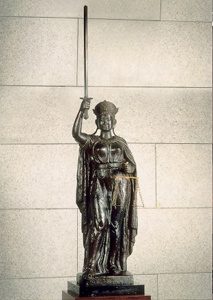
 すなわち,最高裁の女神像は,目隠しをせず,天秤を高く掲げず,剣を振り上げるという,本来の法の女神とは正反対に,偏見・不公平・権力の濫用を助長することを象徴している女神像は,速やかに撤去されるべきであり,本来の法の女神像に変更すべきです。
すなわち,最高裁の女神像は,目隠しをせず,天秤を高く掲げず,剣を振り上げるという,本来の法の女神とは正反対に,偏見・不公平・権力の濫用を助長することを象徴している女神像は,速やかに撤去されるべきであり,本来の法の女神像に変更すべきです。





